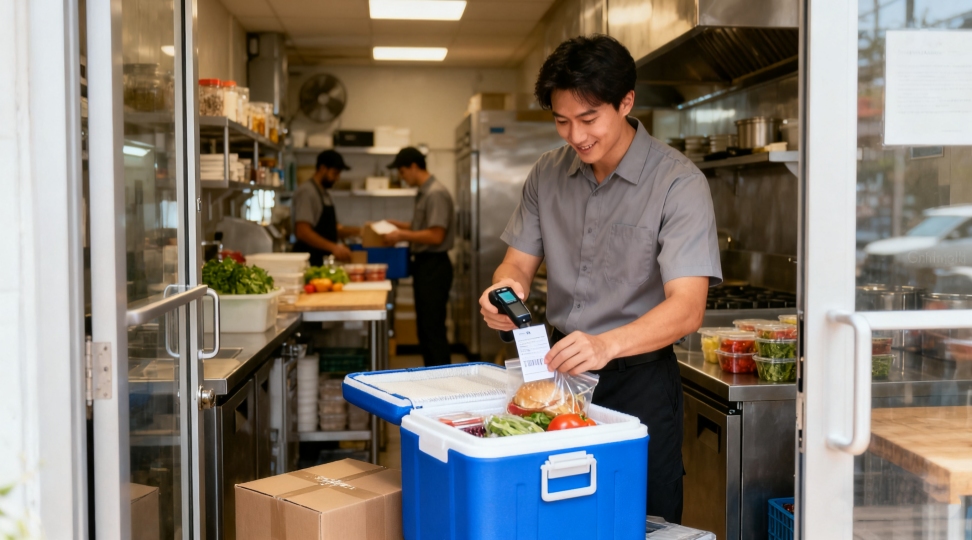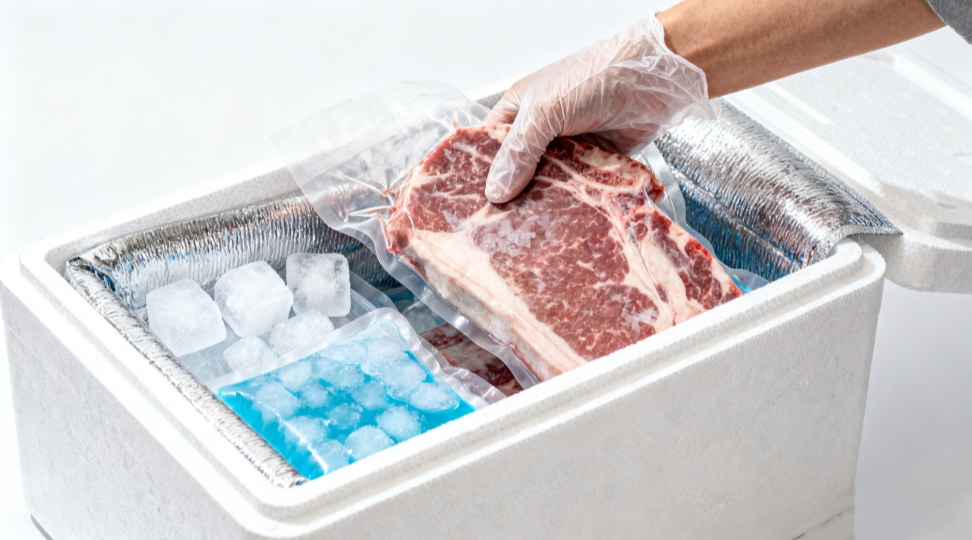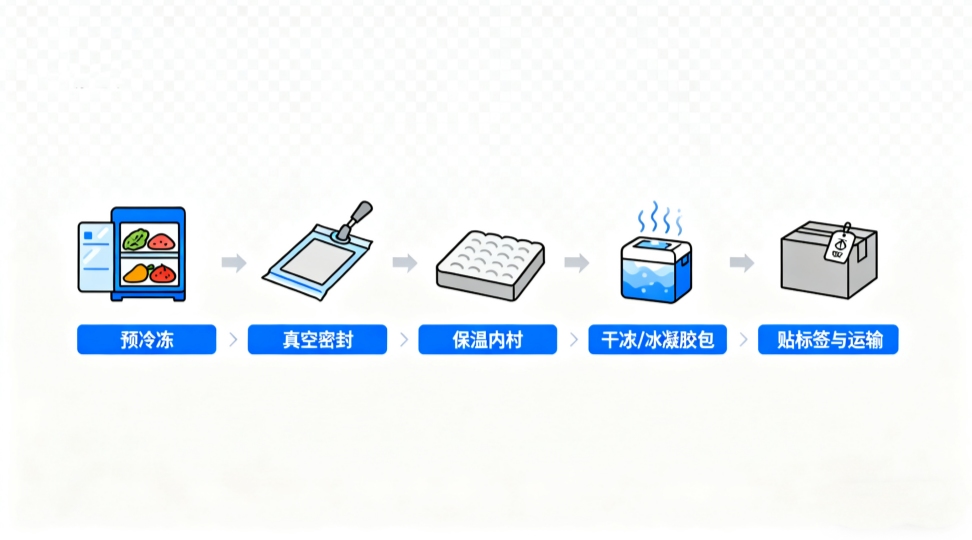Cómo enviar alimentos internacionalmente: Guía completa para enviar alimentos congelados y perecederos
Aprenda cómo enviar alimentos internacionalmente con embalajes seguros para productos congelados, logística de cadena de frío y soluciones DR Trans para exportaciones perecederas.
El envío de alimentos a través de fronteras internacionales es tanto una oportunidad de negocio en crecimiento como un desafío logístico. Para los propietarios de pequeñas empresas y los exportadores comerciales de alimentos, preguntas como Cómo enviar alimentos congelados, Cómo enviar alimentos congelados por correo, o incluso si se pueden enviar alimentos a nivel internacional Son cada vez más comunes. La demanda global de productos perecederos y especiales, desde carnes y mariscos congelados hasta lácteos, productos horneados y comidas preparadas, exige que los exportadores comprendan los procesos de empaque, las regulaciones y los métodos de transporte para garantizar que los alimentos lleguen frescos, seguros y en cumplimiento con las normas.
Esta guía explora todos los aspectos del envío internacional de alimentos, abarcando la preparación, el empaquetado, la logística de la cadena de frío, los modos de transporte, las regulaciones y las preguntas frecuentes. Al finalizar, tendrá una idea clara de cómo enviar alimentos perecederos de forma eficiente y fiable.

1. Comprensión de los conceptos básicos del envío de alimentos
Los alimentos se clasifican como producto perecedero, lo que significa que puede echarse a perder, deteriorarse o volverse inseguro si no se manipula correctamente durante el transporte. A diferencia de los productos no perecederos, los productos congelados y refrigerados requieren un manejo especializado. Si desea saber... ¿Cómo envío comida fría? o Cómo enviar carne congelada En el extranjero, los principios tienen sus raíces en Control de temperatura, integridad del embalaje y cumplimiento de las regulaciones.
Razones clave por las que el envío de alimentos es complejo:
-
Sensibilidad a la temperatura:Los productos congelados deben permanecer por debajo de -18°C, mientras que los productos refrigerados deben mantenerse entre 0°C y 5°C.
-
Sensibilidad temporalLos retrasos pueden comprometer la calidad, especialmente de productos frescos y mariscos.
-
Supervisión regulatoriaLas autoridades aduaneras y de seguridad alimentaria tienen reglas estrictas sobre cómo enviar alimentos a través de las fronteras.
-
Demandas de embalajeEl embalaje adecuado de los productos congelados no es opcional: es esencial.
2. Preparación de alimentos para envíos internacionales
2.1 Evaluación del producto
Antes de enviar, identifique si el artículo está congelados, refrigerados o establesProductos como carne congelada, mariscos o productos lácteos requieren un manejo más estricto en comparación con los snacks envasados o los productos enlatados.
Preguntas que los exportadores deberían plantearse:
-
¿El producto requiere congelación o refrigeración durante el transporte?
-
¿Cuál es la vida útil a temperaturas controladas?
-
¿Cuánto tiempo tomará el tránsito y está dentro de los límites de manipulación segura?
2.2 Procesamiento previo al envío
Congelación antes del envíoAsegúrese de que los productos estén completamente congelados antes de envasarlos. Los productos parcialmente congelados tienen mayor riesgo de deterioro.
-
Sellado al vacío:Extiende la vida útil al minimizar la exposición al aire y a las bacterias.
-
PorcionesLos paquetes más pequeños y sellados individualmente facilitan el manejo y mantienen la calidad.

Aquí, la conclusión principal es: si estás preguntando Cómo puedes enviar alimentos congelados Para transportar el producto de forma segura al extranjero, la preparación adecuada es tan importante como elegir el socio logístico adecuado.
3. Soluciones de embalaje para productos congelados y perecederos
Una de las preguntas más frecuentes que hacen las empresas es Cómo enviar alimentos congelados o Cómo enviar alimentos perecederos Sin deterioro. La respuesta está en la eficacia. embalaje de productos congelados.
3.1 Contenedores aislados
Los contenedores de espuma, los paneles de vacío o las cajas de poliuretano mantienen temperaturas internas estables.
-
Se recomiendan paredes dobles para envíos de larga distancia.
3.2 Refrigerantes
Hielo seco:Ideal para carnes y mariscos congelados, pero sujeto a restricciones de aerolíneas y aduanas (clasificado como material peligroso por encima de ciertos límites de peso).
-
Paquetes de gel:Ideal para productos refrigerados como queso, fruta o productos horneados.
-
Materiales de cambio de fase (PCM):Refrigerantes avanzados diseñados para rangos de temperatura específicos.
3.3 Embalaje exterior
3.4 Lista de verificación de embalaje
Congele previamente los productos completamente.
-
Utilice contenedores aislantes adaptados a los requisitos del producto.
-
Elija el refrigerante adecuado (hielo seco, paquetes de gel o PCM).
-
Etiquete los paquetes con precisión.
-
Garantizar el cumplimiento de las directrices del transportista y de la aduana.
Siguiendo estos principios, reducirá los riesgos al enviar alimentos congelados internacionalmente y aumentará la probabilidad de que lleguen en excelentes condiciones.
4. Logística de la cadena de frío: cómo mantener la seguridad de los alimentos durante el transporte
El cadena de frío Es la columna vertebral del transporte de productos perecederos. Se refiere a la cadena de suministro con temperatura controlada que garantiza la seguridad de los alimentos desde el origen hasta el destino. Si se pregunta... Cómo enviar alimentos congelados por correo o a través de un proveedor logístico, la respuesta depende en gran medida de si el transportista mantiene una cadena de frío confiable.
4.1 Componentes clave de la cadena de frío
Preenfriamiento:Reducir la temperatura del producto antes del envío.
-
Almacenamiento refrigerado:Instalaciones en los puntos de salida y llegada.
-
Contenedores refrigerados:Unidades de temperatura controlada utilizadas en el transporte marítimo.
-
Camiones y vagones frigoríficos:Se utiliza en el transporte terrestre.
-
Monitoreo en tiempo real:Los sensores y los dispositivos IoT rastrean la temperatura, la humedad y el tiempo de tránsito.
4.2 Por qué es importante la cadena de frío
Según el Organización de las Naciones Unidas para la Alimentación y la Agricultura (FAO), cerca de El 14% de los alimentos se pierde antes de llegar a los mercados minoristasLa mala logística es un factor fundamental. Mantener una cadena de frío adecuada no solo es un requisito regulatorio, sino también una necesidad empresarial para los exportadores.

4.3 Fallos comunes de la cadena de frío
Manipulación inadecuada en los puntos de transferencia.
-
Embalaje que no se corresponde con la vida útil del producto.
-
Los retrasos en la aduana prolongan el tránsito más allá de la duración del refrigerante.
Cuando las empresas preguntan ¿Cómo enviar alimentos fríos al extranjero sin riesgo?La respuesta está en asociarse con proveedores que garanticen la integridad de la cadena de frío de extremo a extremo.
5. Métodos de envío: aéreo, marítimo y exprés
La elección del transporte determina tanto el coste como el plazo de entrega. Al decidir Cómo enviar carne congelada o productos frescos, considere el equilibrio entre urgencia y presupuesto.
Mejor para:Carne congelada, mariscos, productos perecederos de alto valor.
-
Tiempo de tránsito:1–5 días.
-
Ventajas:Rápido, confiable, adecuado para envíos urgentes.
-
Contras:Caro, limitado por las regulaciones del hielo seco.
Mejor para: Envíos de alimentos congelados a granel con mayor vida útil.
-
Tiempo de tránsito:15–40 días, dependiendo de las rutas.
-
Ventajas: Rentable para grandes volúmenes.
-
Contras:Más lento, requiere contenedores refrigerados avanzados.
Mejor para:Paquetes pequeños cuando usted preguntar, Poder ¿Envían comida por correo internacional?.
-
Tiempo de tránsito:2–7 días.
-
Ventajas: Despacho de aduanas cómodo e integrado.
-
Contras:Costo de envío por unidad más alto.
Para los pequeños exportadores, el envío de alimentos a través de transportistas exprés suele ser el primer paso hacia la expansión internacional; sin embargo, para ampliar la escala se requiere un uso estratégico del transporte marítimo y aéreo.
6. Regulaciones, documentación y consideraciones aduaneras
Uno de los aspectos más críticos del aprendizaje Cómo enviar alimentos perecederos A nivel internacional, comprender las regulaciones. Cada país tiene sus propias normas sobre qué alimentos se pueden importar, cómo deben declararse y qué documentación se requiere.

6.1 Principios generales de reglamentación
Normas de salud y seguridad:Muchos países siguen las directrices de organizaciones como la Organización Mundial de la Salud (OMS) y el Comisión del Codex Alimentarius.
-
Declaraciones aduaneras:Todos los envíos perecederos requieren facturas precisas, listas de embalaje y certificados de origen.
-
Certificados de seguridad alimentaria:La carne, los lácteos y los mariscos generalmente requieren certificados veterinarios o sanitarios.
-
Normas sobre materiales peligrosos:Si se utiliza hielo seco, el paquete debe estar etiquetado de acuerdo con Reglamento de mercancías peligrosas de la IATA.
6.2 Requisitos de etiquetado
Descripción del producto (por ejemplo, pechuga de pollo congelada, queso lácteo).
-
Peso neto y cantidad.
-
Instrucciones de manejo (“Manténgase congelado”).
-
Fecha de caducidad o de consumo preferente.
6.3 Retrasos en la aduana
Incluso si lo sabes Cómo enviar alimentos congelados Es cierto que las demoras en la aduana pueden causar deterioro si el embalaje es insuficiente. Por eso, los exportadores siempre deben prever refrigerante y aislamiento adicionales.
7. Consideraciones de costos y tiempos de tránsito
El costo es un factor decisivo para muchos pequeños exportadores. El modo de transporte, los requisitos de embalaje y los aranceles aduaneros influyen en el precio final.
A continuación se muestra una tabla comparativa para el envío internacional de alimentos congelados:
| Método de envío | Mejor para | Tiempo promedio de tránsito | Nivel de costo | Limitaciones clave |
|---|
| Carga aérea | Carne congelada, mariscos, productos perecederos de alto valor | 1–5 días | $$$ (Alto) | Límites de hielo seco, caro para grandes cantidades |
| Transporte marítimo (refrigerado) | Grandes volúmenes de alimentos congelados | 15–40 días | $$ (Mediano) | Más lento, requiere una fuerte cadena de frío. |
| Mensajería exprés | Paquetes pequeños, envío de muestras de alimentos | 2–7 días | $$$ (Alto por kg) | Restricciones de tamaño y peso |
| Carretera + Ferrocarril (Intermodal) | Envío regional de productos congelados | 7–20 días | $$ (Mediano) | Limitado por disponibilidad de ruta |
Para los pequeños exportadores que preguntan Cómo enviar alimentos congelados por correoEl servicio de mensajería exprés es conveniente, pero costoso. Para los exportadores consolidados, combinar el transporte aéreo y marítimo suele ser la mejor opción.
8. Preguntas frecuentes sobre el envío de alimentos
Pregunta 1: ¿Se pueden enviar alimentos por correo internacional?
Sí, pero con restricciones. Los productos no perecederos son más fáciles de enviar por correo que los congelados. Empresas de mensajería como DHL, FedEx y UPS permiten envíos congelados con hielo seco, pero tienen límites de cantidad estrictos.
Pregunta 2: ¿Cómo se pueden enviar alimentos congelados sin que se estropeen?
Mediante la precongelación, el uso de contenedores isotérmicos y la elección del refrigerante adecuado (hielo seco o paquetes de gel), es fundamental mantener una cadena de frío fiable.
Pregunta 3: ¿Cómo enviar alimentos fríos a otro país de forma segura?
Seleccione un transportista con experiencia en transporte refrigerado, asegúrese de que el embalaje de los productos congelados sea adecuado y verifique los requisitos aduaneros del país de destino.
Pregunta 4: ¿Cómo enviar carne congelada específicamente?
La carne congelada requiere un control estricto de la temperatura (-18 °C o inferior). Utilice envases sellados al vacío, hielo seco y transporte aéreo o marítimo refrigerado, según la urgencia.
Pregunta 5: ¿Qué documentos se necesitan para enviar alimentos perecederos?
9. Cómo DR Trans apoya a los exportadores de alimentos
En DR Trans, comprendemos la complejidad de la logística internacional de productos perecederos. Ya sea que se pregunte... Cómo enviar alimentos congelados a Rusia, Cómo enviar alimentos perecederos en toda Europa, o ¿Cómo envío comida fría? En Asia Central, nuestras soluciones se adaptan a sus necesidades.
-
Experiencia en cadena de fríoEnvíos de extremo a extremo con temperatura controlada por carretera, ferrocarril, aire y mar.
-
Guía de embalaje de productos congelados:Ayuda para elegir los contenedores aislantes, el hielo seco y los paquetes de gel adecuados.
-
Apoyo regulatorio:Documentación, despacho de aduanas y controles de cumplimiento.
-
Rutas flexibles:Transporte directo TIR para Rusia, contenedores marítimos refrigerados para Europa e integración de mensajería exprés para muestras.
-
Servicios de pago:Opciones de asentamiento seguras para Rusia y Bielorrusia, apoyando el comercio transfronterizo.
Nuestra experiencia garantiza que su carne congelada, mariscos, productos lácteos o alimentos envasados lleguen a tiempo, intactos y cumpliendo con todas las regulaciones.
10. Conclusión
El transporte internacional de alimentos es un equilibrio de Ciencia del embalaje, gestión de la cadena de frío, cumplimiento normativo y estrategia logísticaYa sea que envíe pequeños paquetes congelados a clientes internacionales o gestione exportaciones de carne congelada a granel, los principios son los mismos: prepare los productos con cuidado, invierta en el embalaje de productos congelados y seleccione el método de transporte adecuado.
Para pequeñas empresas y exportadores de alimentos que buscan Cómo enviar comida A través de las fronteras, el camino puede parecer complejo, pero con el socio logístico adecuado, se vuelve manejable.
DR Trans Está aquí para ayudarle a enviar alimentos congelados y perecederos de manera eficiente, segura y a nivel mundial. Desde Asia hasta Europa, Rusia y Asia Central, nuestra red logística integrada garantiza que sus productos mantengan la calidad de puerta a puerta.


















 IPv6 RED SOPORTADA
IPv6 RED SOPORTADA
